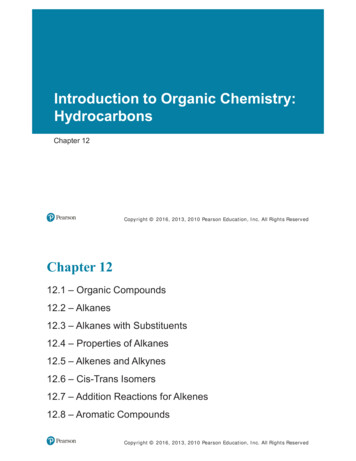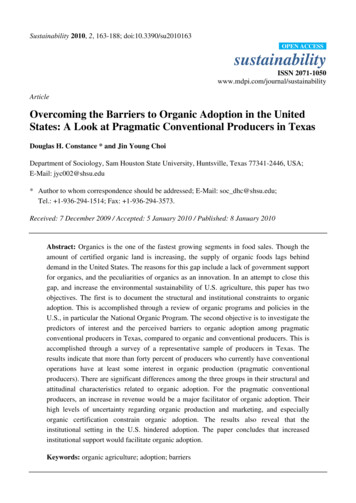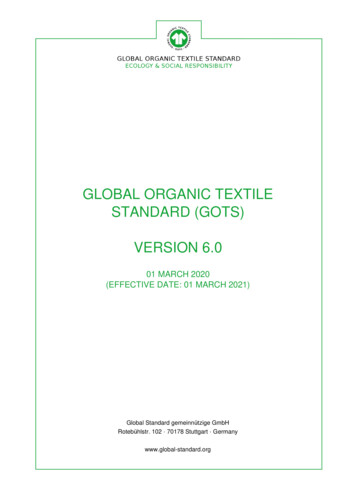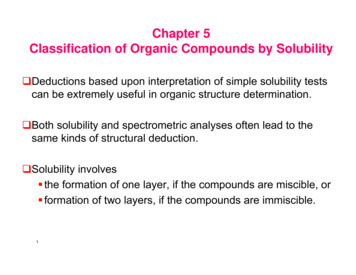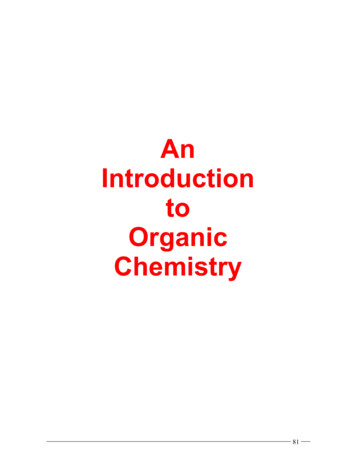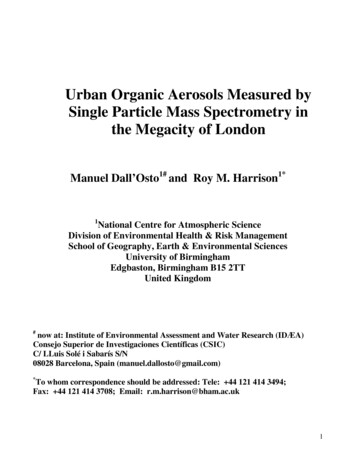
Transcription
Urban Organic Aerosols Measured bySingle Particle Mass Spectrometry inthe Megacity of LondonManuel Dall’Osto1# and Roy M. Harrison1*1National Centre for Atmospheric ScienceDivision of Environmental Health & Risk ManagementSchool of Geography, Earth & Environmental SciencesUniversity of BirminghamEdgbaston, Birmingham B15 2TTUnited Kingdom#now at: Institute of Environmental Assessment and Water Research (IDÆA)Consejo Superior de Investigaciones Científicas (CSIC)C/ LLuis Solé i Sabarís S/N08028 Barcelona, Spain (manuel.dallosto@gmail.com)*To whom correspondence should be addressed: Tele: 44 121 414 3494;Fax: 44 121 414 3708; Email: r.m.harrison@bham.ac.uk1
ABSTRACTDuring the month of October 2006, as part of the REPARTEE-I experiment (Regent’s Park and TowerEnvironmental Experiment) an Aerosol Time-Of-Flight Mass Spectrometer (ATOFMS) was deployedat an urban background location in the city of London, UK. Fifteen particle types were classified, someof which were accompanied by Aerosol Mass Spectrometer (AMS) quantitative aerosol mass loadingmeasurements (Dall’Osto et al., 2009a,b). In this manuscript the origins and properties of four particletypes postulated to be due to locally generated aerosols, independent of the air mass type advected intoLondon, are examined. One particle type, originating from lubricating oil (referred to as Ca-EC), wasassociated with morning rush hour traffic emissions. A second particle type, composed of bothinorganic and organic species (called Na-EC-OC), was found enhanced in particle numberconcentration during evening time periods, and is likely to originate from a source operating at thistime of day, or more probably from condensation of semi-volatile species. A third class, internallymixed with organic carbon and sulphate (called OC), was found to spike both in the morning andevenings. The fourth class (SOA-PAH) exhibited maximum frequency during the warmest part of theday, and a number of factors point towards secondary aerosol production from traffic related volatilearomatic compounds. Single particle mass spectra of this particle type showed an oxidized polycyclicaromatic compound signature. Finally, a comparison of ATOFMS particle class data is made withfactors obtained by Positive Matrix Factorization from AMS data. Both the Ca-EC and OC particletypes correlate with the AMS HOA primary organic fraction (R2 0.65 and 0.50 respectively), and NaEC-OC, but not SOA-PAH, which correlates weakly with the AMS OOA secondary organic aerosolfactor (R2 0.35). A detailed analysis was conducted to identify ATOFMS particle type(s)representative of the AMS COA cooking aerosol factor, but no convincing associations were found.2
1.INTRODUCTIONTropospheric particles contain a significant and variable fraction of organic material, ranging from 20%to 90% of the fine particulate mass (Kanakidou et al., 2005) and divide into two broad categoriestermed primary and secondary. Primary organic aerosols detected in urban areas are mainly directlyemitted from combustion sources, including heavy and light duty vehicles, wood smoke, cookingactivities, industries and many others. Once primary particles are emitted they are modified in thepresence of various atmospheric oxidants, yielding secondary organic aerosols (SOA) with distinctlydifferent chemical and physical properties compared to their precursor primary particles (Donahue etal., 2009).SOA is also formed from reactions of volatile organic compounds (VOC). SOA consists of a mixtureof oxygenated organic species dependent on the degree of processing of the aerosol in the atmosphere,and the precise mechanisms of formation and evolution of SOA are still highly uncertain (Hallquist etal. 2009). The sources and the production mechanisms of primary and secondary organic aerosolsrepresent one of the biggest uncertainties in aerosol science. Models informed by chamber experimentsdo not always capture the variability of observed SOA loadings, and often predict far less SOA than isobserved (Hallquist et al. 2009). This underestimation of SOA strongly suggests the importance ofadditional pathways of SOA formation not typically studied in laboratory experiments or included inmodels (Zhang et al. 2007). The chemistry of the formation and continuing transformation of lowvolatility species in the atmosphere has been the subject of recent review articles (Kanakidou et al.,2005; Goldstein and Galbally, 2007; Kroll and Seinfeld, 2008). Until recently, organic particulatematerial was simply classified as either primary or secondary with the primary component being treatedin models as nonvolatile and inert. However, the simplified models failed to explain a number of keyaspect of the aerosols, including the highly oxygenated nature of ambient OA and the highconcentrations of OA during periods of high photochemical activity. Recent studies have shown that3
semi-volatile components of primary aerosols desorb into the gas phase during aerosol transport,thereby undergoing oxidation in the gas phase, leading to SOA formation (Robinson et al., 2007). Thisopens the possibility that low-volatility gas-phase precursors, including long chain n-alkanes, PAHsand large olefins, are a potentially large source of SOA.Polycyclic Aromatic Hydrocarbons (PAH) have been identified as a major component in emissionsfrom diesel engines and wood burning sources (Schauer et al., 1999; 2001). The photo-oxidation ofthese compounds has been shown to yield high molecular weight (MW) oxygenated compounds(Sasaki et al., 1997; Bunce et al., 1997; Wang et al., 2007), which can partition into the particle phaseand lead to significant SOA formation (Mihele et al., 2002). Current atmospheric models do notnormally include secondary organic aerosol (SOA) production from gas-phase reactions of polycyclicaromatic hydrocarbons (PAHs). Chan et (2009) reported a laboratory study of secondary organicaerosol formation from photooxidation of naphthalene and alkylnaphthalenes. Although the gas-phaseemissions were dominated by low molecular weight aromatics, these compounds were estimated toaccount for only 14% of the SOA formed in first 3 h of photooxidation. The estimate is consistent withlaboratory results of photooxidation of diesel exhaust (Robinson et al., 2007), in which the “known”consisting primarily of single-ring aromatics gas phase precursors, account for at most 15% of the SOAformed. The contribution of PAH to SOA is still significant after 12 h of oxidation, at which point theSOA from PAH is about twice that from light aromatics (Chan et al., 2009).Whilst biogenic precursors (predominantly monoterpenes) have traditionally been thought to dominateregional SOA formation, anthropogenic compounds may contribute an appreciable fraction of SOA inurban areas. Mono-aromatic hydrocarbons are one of the most abundant types of organic compoundfound in the urban atmosphere. Langford et al. (2010) recently reported fluxes and concentrations ofvolatile organic compounds above central London, estimating that traffic activity was responsible for4
about 70% of the aromatic compound fluxes. The ultimate photo-oxidation products of many relativelysimple mono-aromatic species remain unknown, due to the complexity and low concentrations formed.The incorporation of a mono-aromatic compound into polymeric compounds with acetal polymers wasalso suggested (Kalberer et al., 2004).In recent years aerosol mass spectrometry has become available as a powerful tool for the on-linechemical characterization of individual aerosol particles (Murphy, 2007) or small aerosol ensembles(Canagaratna et al., 2007). During the month of October 2006, the REPARTEE-I campaign (Regent’sPark and Tower Environmental Experiment) studied atmospheric chemical processes, and particularlythose affecting atmospheric aerosol, in London. Two different particle mass spectrometers weredeployed: an Aerodyne Compact Time-of-Flight Aerosol Mass Spectrometer (C-ToF-AMS) (Drewnicket al., 2005) and an Aerosol Time-of-Flight Mass Spectrometer (ATOFMS) (Gard et al., 1997). TheATOFMS provides single particle information on the abundance of different types of aerosol particlesas a function of particle size with high time resolution, whereas the AMS measures quantitatively massconcentrations of the non-refractory aerosol components as well as species-resolved size distributions(Canagaratna et al., 2007).These types of on-line aerosol analysis instrumentation have greatly advanced our understanding ofatmospheric chemistry and climate (Sullivan and Prather, 2005). Whilst the AMS has providedadvances in the source apportionment of primary versus secondary organic aerosol components(Canagaratna et al., 2007), the ATOFMS has less adequate source apportionment capabilities due to thedifficulties in quantification of its outputs. However, as a main objective of this study, we investigatethe temporal trends and the mass spectral features of specific particle types classified with theATOFMS and we try to deduce chemical and physical aerosol features, attempt a source identification5
and compare the results with those obtained by using an AMS deployed during the same field study(Allan et al. 2010).A number of papers generated during the REPARTEE experiment have already been published.During the REPARTEE-I field study for example, the ATOFMS focused on atmospheric chemicalprocesses (Dall’Osto et al 2009a, b). Dall’Osto et al. (2009a) found two types of nitrate-containingaerosols: the first (33.6% of particles by number) appeared to be locally produced in urban locationsduring nighttime, whilst the second (22.8% of particles by number) was regionally transported fromcontinental Europe. Dall’Osto et al. (2009b) reported on aerosol formation processes during a fog eventwithin the campaign period. By applying Positive Matrix Factorization (PMF) on the organic AMSmatrix, Allan et al. (2010a) reported a detailed source apportionment analysis of the organic aerosols.In summary, three OA contributions were identified in REPARTEE I: secondary Oxygenated OrganicAerosols (OOA, 53%), primary Hydrocarbon-like Organic Aerosol (HOA, 25%) and primary CookingOrganic Aerosol (COA, 22%) but a comparison with the ATOFMS results was not attempted. Table 1summarizes the 15 clusters found during the REPARTEE I field study. Twelve of the 15 clusterscontained mass spectral peaks characteristic of organic containing aerosols, accounting for 83.7% ofthe total particles classified (see Table 1). Of these, the 3 main clusters were associated also with nitrateaerosol and are already discussed in Dall’Osto et al. (2009a). Two specific ATOFMS clustersassociated with secondary organic aerosol production during a fog event have already been discussed inDall’Osto et al. (2009b). The present study aims to present a detailed analysis of some specificATOFMS particle classes not described in other studies. The particle types herein described werepredominantly organic particle types presenting systematic diurnal trends persisting over three weeksand therefore attributable to local primary and secondary processes occurring daily at the local scaleand independent of whichever air mass type the city of London was exposed to. Aspects of the data are6
compared with the source attribution results for organic carbon derived from PMF analysis of AMSdata collected during the same campaign by Allan et al. (2010a,b).The ATOFMS collects individual particles whilst the AMS collects an ensemble of particles which canbe interpreted as a mass concentration of the major non-refractory components. The AMS thusmeasures the particle mass loading (μg m 3) whilst the ATOFMS temporal trend is reported as thenumber of particles detected (ATOFMS counts per hour), but the correlation can be very good(R2 0.75) (Dall’Osto et al., 2009a). This study does not aim to look at general organic and inorganiccomponents, but aims to present specific four organic particle types occurring during this study, whichhave not been reported in our earlier papers (Dall’Osto et al., 2009 a,b).2.EXPERIMENTAL2.1Aerosol samplingSampling took place in Regents Park, one of the Royal Parks of London between 4th and 23rd October2006. Regents Park is located in the northern part of central London. The park has an outer ring roadcalled the Outer Circle (4.3 km) and an inner ring road called the Inner Circle. Apart from two linkroads between these two, the park is reserved for pedestrians and the ca. 2 km² park is mainly openparkland. The sampling site chosen was inside the inner circle, in an open area usually reserved forparking and gardening purposes. All the instruments were housed in a mobile laboratory. The site wasoperated as part of the REPARTEE-I experiment (Regent’s Park and Tower EnvironmentalExperiment) aiming to study atmospheric chemical processes, and particularly those affectingatmospheric aerosol, in London (Harrison et al. 2011). Meteorological, gas-phase and aerosolmeasurements were conducted from the top of a 10 m high tower constructed on site. To minimisesampling losses, aerosol was drawn down a sampling stack from which it was iso-kinetically subsampled into a 2 cm diameter stainless steel tube leading to the mobile laboratory. Local7
meteorological conditions were measured by humidity and temperature probes, and a sonicanemometer which measured the 3-D wind field at the sampling site.2.2InstrumentationThe ATOFMS collects bipolar mass spectra of individual aerosol particles. Ambient aerosol is focusedinto a narrow particle beam for sizes between 100 nm and 3 µm. Using a 2-laser velocimeter particlesizes are determined from particle velocity after acceleration into the vacuum. In addition, the lightscattered by the particles is used to trigger a pulsed high power desorption and ionization laser (λ 266nm, about 1 mJ/pulse) which evaporates and ionizes the particle in the centre of the ion source of abipolar reflectron ToF-MS. Thus, a positive and negative ion spectrum of a single particle are obtained.The mass spectrum is qualitative in that the intensities of the mass spectral peaks are not directlyproportional to the component mass but are dependent on the particle matrix, the coupling between thelaser and the particle and the shot to shot variability of the laser. However, the ATOFMS can providequantitative information on particle number as a function of composition; providing a measure of allparticle components and can be used to assess mixing state. The ATOFMS provides information on theabundance of different types of aerosol particles as a function of particle size with high time resolution(Gard et al., 1997). Recent studies (Jeong et al. 2011) report excellent correlations between inorganicspecies (sulphate, nitrate and ammonium) and total organic and elemental carbon detected withATOFMS and other instruments such as the AMS, the Gas-Particle Ion Chromatograph (GPIC), andthe Sunset Lab field OCEC analyzer. However, there are no intercomparisons between specific PMFfactors derived from the AMS organic matrix (Ulbrich et al, 2009; Allan et al. 2010) and ATOFMSclustering results.ATOFMS laser desorption/ionization of chemical species in the particles is accomplished using aNd:YAG laser operating at 266 nm, and PAHs and their heterocyclic analogues present very high8
molar absorptivity at this wavelength therefore it is expected that these compounds will be detectedamong the most easily of all compounds using ATOFMS. The laser fluence of the LDI laser of theATOFMS was kept very low (0.8- 0.9 mJ per pulse) in comparison to other studies (1.3-1.6 mJ). Thereason for selecting lower laser fluence was to reduce the fragmentation of organic compounds, henceenhancing the detection of high molecular weight species as molecular ions (Silva and Prather, 2000).As a result, a wider variety of particle mass spectra is generated and can provide a better understandingof the different sources and processes occurring in the urban atmosphere.A Multi-Angle Absorption Photometer (MAAP, Thermo Electron) (Petzold and Schonlinner, 2004)was also used to measure 1-minute averages of the ambient black carbon concentrations. Moreover,Dichotomous Partisol-Plus Model 2025 sequential air samplers, fitted with PM10 inlets were deployedfor collecting fine (PM2.5) and coarse (PM2.5-10) fractions. A number of other instruments were usedduring the REPARTEE-I campaign but are not listed here since their data are not discussed in thispaper. Local meteorology was determined by a Weather Transmitter WXT510 (Vaisala Ltd,Birmingham) probe. Gas measurements were obtained by Thermo Environment 42CTLchemiluminescence gas analyser with thermal converter and by Thermo Environment 49C photometricUV analyzer for NOx and ozone, respectively.2.3Data analysisThe ATOFMS was deployed at Regents Park for 19 days, between 04/10/06 at 17:00 and 22/10/06 at23:00. In total, 153595 particles were hit by the ATOFMS. The TSI ATOFMS dataset was importedinto YAADA (Yet Another ATOFMS Data Analyzer) and single particle mass spectra were groupedwith Adaptive Resonance Theory neural network, ART-2a (Song et al., 1999). The parameters used forART-2a in this experiment were: learning rate 0.05, vigilance factor 0.85, and iterations 20. Furtherdetails of the parameters can be found elsewhere (Dall'Osto and Harrison, 2006). An ART-2a areamatrix (AM) of a particle cluster represents the average intensity for each m/z value for all particles9
within a group. An ART-2a AM therefore reflects the typical mass spectrum of the particles within agroup. The ART-2a algorithm generated 306 clusters used to describe the dataset. By manuallymerging similar clusters (Dall’Osto and Harrison, 2006), the total number of clusters describing thewhole database was reduced to 15. Throughout this paper, an ATOFMS particle type is synonymouswith an ATOFMS cluster. It is important to stress the fact that whilst the ATOFMS provides importantinformation on the mixing state of the aerosols and temporal trends of unique particle types over time,the total number of particles sampled by the instrument does not have quantitative meaning withoutextensive calibrations as it is biased by transmission efficiency (Dall’Osto et al., 2006). Whilst somesemi-quantitative ATOFMS measurements have been reported (i.e. Qin et al., 2006) in the literature, noattempt was herein tried to scale ATOFMS measurements with other instruments.3.RESULTSThis paper focuses on four particle types named Ca-EC (Calcium – Elemental Carbon), OC (OrganicCarbon), Na-EC-OC (Sodium – Elemental Carbon – Organic Carbon) and SOA-PAH (SecondaryOrganic Aerosols – Polycyclic Aromatic Hydrocarbons) accounting for 4.3%, 3.6%, 1.7% and 2.2%(respectively) of the ATOFMS particles classified during the REPARTEE I experiment.The weather during the field study was characterized by unusually warm conditions for the month ofOctober in the UK (average temperature 14.1 2.8C, relative humidity 82.6 10.7%; mean 1 s.d. ofhourly data). The predominant origin of air masses arriving at the receptor was westerly, with Atlanticair masses not strongly influenced by anthropogenic pollution. However, during two periods, airmasses arriving at our site from mainland Europe (mainly France and Poland) were detected on 10–11October 2006 and on 14–20 October 2006. Local wind direction roses were calculated for all 15ATOFMS clusters, and ATOFMS particle types associated with regional and continental aerosols were10
found to be associated predominantly with an easterly origin. ATOFMS particle types characterized bydaily diurnal profiles were mainly associated with south and east directions, where main roadsbordering the Regents Park are located.3.1ATOFMS characterization3.1.1 ATOFMS mass spectraThe positive and negative ART-2a AMs for the four particle types described are presented in Figure 1.The mass spectra of cluster Ca-EC (Figure 1a) show a strong signature due to calcium (m/z 40, 56, 57and 96), EC (m/z -36, -48, -60) and OC (m/z 27, 29, 43). Strong signals in the negative mass spectrumare associated with nitrate (m/z -46, -62), whereas sulphate (m/z -97) is almost absent. This isconsistent with a source in vehicle exhaust, which is rich in NOx but depleted in SO2 due to use of lowsulphur fuel. This particle type has previously been associated with combusted lubricating oil emittedby traffic (Spencer et al., 2006; Toner et. al 2007) and consistently called Ca-EC although in thisREPARTEE study a higher signal of nitrate is seen in the negative spectra (Fig. 1a).Figure 1b shows the ART-2a AMs for cluster OC: strong signals due to organic fragments are seen atm/z 27, 29, 43, 51, 57 and 63. This particle, by contrast with the Ca-EC type, is internally mixed withboth nitrate and sulphate, with a higher signal for the latter. Cluster Na-EC-OC (Figure 1c) shows asignal at m/z 23 for the inorganic component sodium, not seen in other mass spectra presented inFigure 1 and suggesting a different source. Moreover, beside the OC and EC component associatedwith the Na-EC-OC particle type, the negative spectra of this particle type also show signals due toinorganic nitrogen (m/z -26 [CN] and m/z -42 [CNO]), also not seen clearly in the other particle types.Cluster SOA-PAH presents a unique positive mass spectrum (Figure 1d), with strong peaks at m/z 27[C2H3] and m/z 43 [(CH3)CO] . M/z 51 [C4H3] , 63 [C5H3] , 77 [C6H5] and 91 [C7H7] are indicative11
of a strong aromatic signature (McLafferty, 1993). In the positive mass spectrum, the major peaks atm/z above 100 amu show a series at m/z 115, 128, 141, 152, 165, 178, 189, 202, 215, 226, 239 and 252which is usually attributed to PAH compounds (Gross et al., 2000; Silva and Prather, 2000). Figure 2shows positive and negative mass spectra of a single particle (aerodynamic diameter 400 nm)belonging to the ATOFMS particle type SOA-PAH. Additional peaks at m/z 180, 194, 208, 222, 236,262 and 276, characteristic of oligomeric species with saturated carbon skeletons separated by Δ14 arepresent in addition to the PAH series separated by Δ13. Other peaks at m/z above 100 can be clearlyseen with a series at m/z 105, 119, 133 and 147, possibly associated with benzoyl groups andunsaturated or cyclic phenoxy moieties (McLafferty, 1993). The peaks at m/z 69, 81 and 95(particularly the strong peak at m/z 95) may represent the exo-sulphur aromatic series (sulphur attachedto an aromatic ring) (McLafferty, 1993).The single particle ATOFMS negative mass spectrum of cluster SOA-PAH (Figure 2) is dominated bym/z -25 and m/z -26 (likely to be [C2H]- and [C2H2]- respectively) and m/z at -49 and m/z -73 (oftenfound strongly correlated and likely to be related by an unknown fragmentation pattern), which areoften associated with fragmentation of PAH and unsaturated organic compounds (Silva and Prather,2000; Spencer et al., 2006). The presence of strongly acidic compounds is indicated by peaks in thenegative spectra. Along with the common peak at m/z -97 [HSO4]-, peaks at m/z -80 [SO3]-, m/z -81[HSO3]- and m/z -64 [SO2]- can be seen. The peak at m/z -81 suggests the particle is highly acidic(Whiteaker and Prather, 2003). It is interesting to note the minor presence of common peaks due tonitrate (i.e. m/z -46 [NO2]-, m/z -62 [NO3]- and m/z -125 [H(NO3)2]-. Perhaps the most interestingfeature of the negative mass spectrum of Figure 2 is the presence of other oxygenated aromatic ringsindicated by peaks not reported before in ATOFMS mass spectral characterization seen at m/z -107,m/z -121 and m/z -137, characteristic of fragmentation patterns often associated with flavonoids(Cuyckens and Claeys, 2004; Maul et al., 2008). By querying the whole ATOFMS dataset (about12
150,000 single particle mass spectra), it was found that m/z -107, m/z -121 and m/z -137 were uniqueto this particle type. In summary, the positive and negative ATOFMS mass spectra of particle typeSOA-PAH indicate a highly oxidised organic aerosol component internally mixed with acid sulphatespecies, along with a complex signature at higher m/z which is attributable to high molecular weightpolyaromatic compounds.3.1.2 ATOFMS size distributionsATOFMS size distributions were obtained by scaling the ATOFMS particle number counts withparticle number size distributions to calibrate inlet efficiencies (Qin et al., 2006). It should be stressedthat the size distributions presented in this work have only semi-quantitative meaning, as the ATOFMSefficiency is different for different particles and each broad type of particles exhibits a different hit rate(Dall’Osto et al., 2006, Reinard et al., 2007). Whilst the ATOFMS measures precisely the vacuumaerodynamic diameter of individual particles (0.01μm resolution), particles were summed between200nm and 3500nm at 100nm intervals for simplification. Figure 3 shows the size distributions for thefour ATOFMS particle types Ca-EC, OC, Na-EC-OC and SOA-PAH. Clusters Ca-EC and OC show auni-modal distributions peaking in the smallest detectable ATOFMS particle diameter at about 200nm.Previous ATOFMS findings point to primary combustion particles peaking at the smallest detectableATOFMS particle diameter, whilst more aged secondary organic components (i.e. long range transportorganic aerosol) are more typically distributed in the accumulation mode at around 500nm (Sullivanand Prather, 2005). The mass spectra of these two particle types described in section 3.1.1, along withthe size distributions herein presented, suggestive of a primary origin of these particles.Cluster Na-EC-OC also shows a mode peaking at the smallest sizes, but much less pronounced relativeto clusters Ca-EC and OC. By contrast to the first three clusters presented so far, cluster SOA-PAHshows a mode peaking at about 350nm and not peaking at the smallest detectable ATOFMS particle13
diameter. The coarser mode of cluster SOA-PAH relative to clusters Ca-EC and OC suggests adifferent origin not related to primary emissions.3.2.Time trend analysis3.2.1 Overview of the temporal trendsThe temporal trends (3 hours resolution) of the four ATOFMS clusters are presented in Figure 4.Clusters Ca-EC and OC (Figure 4a) showed maximum abundance during the morning of 13th October2006, when low wind speed was associated with stagnant conditions, also reflected in highconcentrations of primary traffic related species (BC, NO, NOx, Figure 4b). Figure 4c shows thetemporal profiles of the 3 PMF factor components of the AMS organic matrices described in Allan et al.(2010a). The AMS OOA component dominated the periods of 9th-10th and 14th-20th October 2006affected by continentally influenced air masses, in which the ATOFMS showed nitrate internally mixedwith elemental carbon and organic carbon (Dall’Osto et al., 2009a). AMS factor HOA shows itsmaximum on the morning of 13th October, and other high concentrations during the morning rush hoursof 11th, 12th, 16th and 17th October, correlating with the maximum values of ATOFMS cluster Ca-ECrelated to primary traffic emissions (Figure 4a-c). The highest concentrations of cluster SOA-PAH(Figure 4a) occurred on 11th and 17th-20th October, which are also the days where AMS cluster COApresents its higher mass loading concentrations during daytime (Figure 4c).3.2.2 Diurnal profilesThe temporal trends derived from a number of other instruments appear in Figure 5, showing theaverage diurnal profiles of (a)ATOFMS clusters described in Figure 1, (b) AMS PMF factors asreported in Allan et al. (2010a); (c) ozone, NOx and BC concentrations; (d) relative humidity and14
temperature and (e) ATOFMS hit particles with m/z 55 (peak height 100). ATOFMS Cluster Ca-EC,as expected from its mass spectra and size distribution, exhibits a maximum during morning rush hours(05:00-09:00) due to primary traffic emissions (Figure 5a). It shows the same traffic rush hours peaksas NOx and BC (Figure 5c), along with the primary organic aerosol traffic related HOA (Figure 5b)derived by the AMS (Allan et al., 2010a). During rush hours BC concentrations were around 4 µg m-3,NOx concentrations about 20 ppb, and HOA about 1.5 µg m-3. A second peak at about 16:00 due to thesecond traffic rush hour period is evident in Figure 5 from the ATOFMS cluster Ca-EC and NOxdiurnal trends. Cluster OC (Figure 5a) also showed a spike in the morning traffic rush hour, reflectedby a good correlation with cluster Ca-EC (R2 0.7). However, cluster OC also exhibited a secondsharper peak during evening hours spiking at about 21:00. Cluster Na-EC-OC did not show as strong adiurnal profile as the previous classes described (Figure 5a) but a two fold increase occurred between18:00 and 24:00 relative to the other hours of the day suggesting an additional evening aerosol sourceor atmospheric process responsible for this particle type. Figure 5a shows that in contrast to the otherthree ATOFMS particle types presented so far, ATOFMS particle type SOA-PAH exhibits a peak inthe middle of the day. This cluster exhibits a bimodal daily trend: the earlier mode starts at about 08:00,as temperature also rises (Figure 5d) and lasts for about 3 hours. The second mode, peaking at 12:00and 13:00 is in the hottest part of the day. Concentrations decrease substantially after 14:00,disappearing by about 19:00 (Figure 5a).The diurnal profile of particles detected by the ATOFMS containing a peak with significant signal(peak height 100) at m/z 55 (Figure 5d) is also shown but is discussed in Section 4.3.2.3 Weekday-weekend trendAverage mean values ( 1 standard deviation) of the weekday-weekend (WD-WE) variation wasperformed on all 15 clusters derived from the ca- 150,000 single particles detected during theREPARTEE-I campaign. The two clusters with the highest weekday to weekend ratio were found to be15
cluster Ca-EC (weekdays: 16 15; weekend: 8 6; average ATOFMS counts/hour) and cluster SOAPAH (15 25; 3 7). Whilst clusters Ca-EC and clust
University of Birmingham Edgbaston, Birmingham B15 2TT United Kingdom # now at: Institute of Environmental Assessment and Water Research (IDÆA) . (Regent's Park and Tower Environmental Experiment) an Aerosol Time-Of-Flight Mass Spectrometer (ATOFMS) was deployed at an urban background location in the city of London, UK. Fifteen particle .
